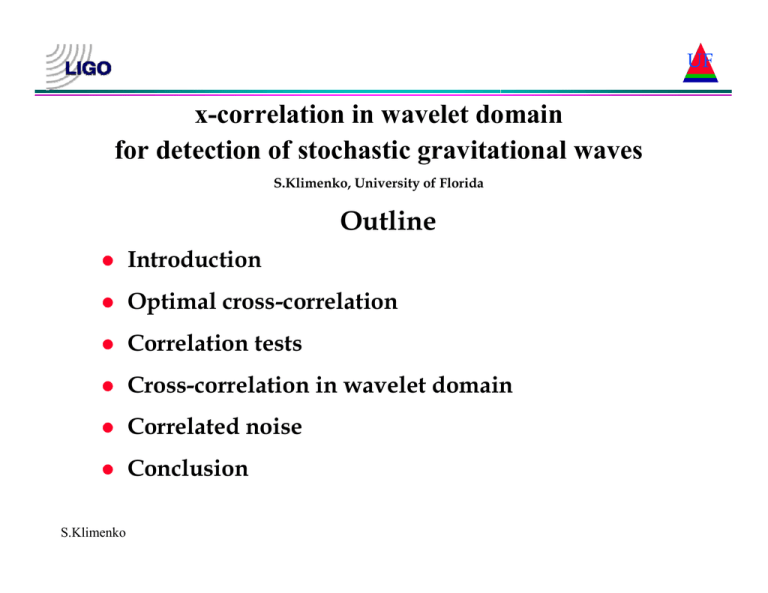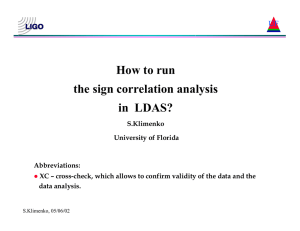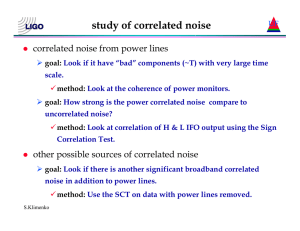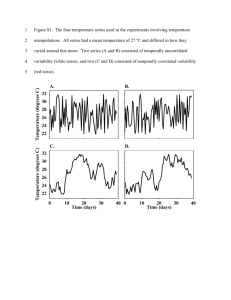x-correlation in wavelet domain for detection of stochastic gravitational waves Outline
advertisement

UF
x-correlation in wavelet domain
for detection of stochastic gravitational waves
S.Klimenko, University of Florida
Outline
z
Introduction
z
Optimal cross-correlation
z
Correlation tests
z
Cross-correlation in wavelet domain
z
Correlated noise
z
Conclusion
S.Klimenko
Introduction
z
Stochastic Gravitational Waves
¾ from early universe or/and large
number of unresolved sources
(GW energy density)/(closure density)
ΩGW < 10
z
Detection of SGW
−5
UF
Ω
Ω
Ω
=1
=
=
10 -
7
0 -9
10 -
11
¾ x-correlation of detectors output sL(t) and sH(t)
T
T
0
0
S = ∫ dt ∫ dt ′sL (t ′) sH (t )Q (t − t ′, Ω L , Ω H )
¾ Q - optimal kernel, T – observation time
¾ ΩH (ΩL) is the orientation of H (L) interferometer
S.Klimenko
al
i
t
i
w in
w
ad
v
ed
c
an
Optimal Cross-Correlation
z
x-correlation in Fourier domain
Sep 96)
UF
(B.Allen,J.Romano gr- qc/ 9604033 v3 30
∞
S = ∫ df ~
sH ( f )~
sL* ( f )Q ( f , Ω L , Ω H )
−∞
¾ Optimal kernel:
9 ΩGW − SGW strength
| f | −3 Ω GW ( f )γ ( f , Ω L , Ω H )
Q( f , Ω L , Ω H ) =
PL ( f ) PH ( f )
9 PL, PH - spectral densities of detector noise
9 γ – detector overlap function
z
(E. Flanagan, Phys. Rev. D48, 2389 (1993))
Questions:
¾ What is distribution of S if noise is not Gaussian?
¾ What to do if noise is not stationary?
¾ What to do if S is affected by correlated (©) noise?
S.Klimenko
Correlation Tests
z
linear correlation test
r=
∑ (x
∑ (x
− x )( y i − y )
i
i
i
− x)
2
∑ (y
i
− y)
2
w- correlation coefficient
¾ parametric: no universal way to compute r distribution
¾ if data is not Gaussian, r is a poor statistics to decide
9 correlation is statistically significant
9 one observed correlation is stronger then another.
z
rank correlation test
¾ non-parametric: exactly known r distribution
¾ effective but CPU inefficient for large data sets
S.Klimenko
UF
Sign Correlation Test
z
ui = sign( xi − xˆ )
Sign transform:
¾
x̂
- median of x
si = sign( xi − xˆ ) ⋅ sign( yi − yˆ )
z
Sign statistics:
z
Correlation coefficient γ:
z
Distribution of γ (n – number of samples):
very robust:
¾ error from
S.Klimenko
x̂
and
γ = mean( si )
nγ 2
n
P ( n, γ ) ≈
⋅ exp −
2π
2
¾ Gaussian (large n):
z
UF
ŷ
~2/n2, much less then var(γ )=1/n for large n
Comparison of Correlation Tests
z
z
Data: simulated uncorrelated noise (n) + Gaussian signal (g)
x = nx + g ,
y = ny + g
Test efficiency: εs = rs/rL
wcorrelation coefficient
¾ for Gaussian noise
9 rank test efficiency – 95%
9 sign test efficiency - 64%
(2.5 times more data)
¾ independent on SNR
wnoise distributions
S.Klimenko
wsign test efficiency
UF
Wavelet Transforms
z
time-frequency representation of data in wavelet domain
¾ Pmn : n – scale (frequency) index, m – time index
z
due to of locality of wavelet basis, wavelet layers are
decimated time series (similar to windowed FT).
z
X-correlation
S=∑
nm
T
T
0
0
∑p
q I
kl mn kl , mn
k ,l
I kl ,mn = ∫ dt ∫ dt ′ψ kl (t ′)ψ mn (t )Q (t − t ′, Ω L , Ω H )
¾ Ψnm – basis of wavelet functions
S.Klimenko
UF
Cross-Correlation in Wavelet Domain
z
UF
x-correlation is a sum over wavelet layers
S = ∑ wn (τ )rn (τ )
n ,τ
∞
wn (τ ) = N n ∫ df ψ n ( f )
−∞
z
2
ΩGW ( f )γ ( f , Ω L , Ω H ) σ nL σ nH
.
exp(− j 2πfτ )
3
PL ( f ) PH ( f )
f
¾ τ – time lag
¾ n – wavelet layer number
¾ Nn – number of samples in layer n
¾ rn(τ) – correlation coefficients as a function of leg time τ
¾ wn(τ) – optimal weight
9Ψn – Fourier image of mother wavelet for layer n
9 σ nL ,σ nH - noise rms in wavelet domain for detector L (H)
equivalent to S calculated in Time & Fourier domains
S.Klimenko
Sign X-Correlation in Wavelet Domain
z
z
replace rn(τ) with γn(τ) - sign correlation coefficients
To keep the weights optimal, take into account the sign
correlation efficiency εn
~ (τ )γ (τ ), w
~ (τ ) = w (τ )ε
S = ∑w
s
z
n ,τ
n
n
n
n
γn(τ) are normally distributed with variance 1/Nn
¾ then the x-correlation variance is:
z
n
var( S s ) = ∑
n ,τ
1 ~2
wn (τ )
Nn
What we gain/loose
¾ sign test is less efficient (65%) when data is Gaussian:
¾ if data is not Gaussian
9 the sign test can be more efficient
9 gain confidence in calculation of S distribution
S.Klimenko
UF
Robust Spectral Amplitude
z
Optimal weight
∞
2
~
wn (τ ) = N n ∫ df ψ n ( f ) f
−∞
z
−3
ΩGW ( f ) ⋅ γ ( f , Ω L , Ω H )
exp(− j 2πfτ )
AL ( f ) ⋅ AH ( f )
“noise amplitude”
AI ( f ) =
PI ( f )
σ nI ε n
z
A(f) is more robust then P(f) if noise is non-stationary
z
test with simulated noise
¾ Gaussian noise (σg) + tail :
σ
n
/σ
1.0
1.45
2.31
S.Klimenko
g
P
0.45
0.94
2.40
total rms σn
A
0.0266
0.0274
0.0273
UF
© Noise
UF
C = hL + nL , hH + nH = hL , hH + nL , nH
wSGW (infinite CTS)
w“good” (uncorrelated) noise
w“bad” © noise
w“ugly” © noise
~T
~T
~ T
~ T
z
z
remove “bad” © noise (likely to be data processing artifacts)
How to deal with “ugly” © noise?
S.Klimenko
Autocorrelation Function
z
z
sign statistics s(t)={uxuy}
a(t) - autocorrelation function of s(t)
¾ a measure of correlated noise.
wX-correlation of
wL1:AS_Q & H2:AS_Q
win wavelet domain:
w32-64 Hz band
S.Klimenko
wE7 data
UF
Noise Model in SCT
z
UF
uncorrelated noise
a(0) = 1, a(τ ≥ ∆t ) = 0
¾ autocorrelation function:
¾ null hypothesis: data sets are not correlated
¾ variance:
z
1
var 0 ( γ ) =
n
correlated noise with time scale <Ts
¾ autocorrelation function:
a(τ < Ts ) = an (τ ), a(τ > Ts ) = 0
¾ null hypothesis: data sets are not correlated at time scale >Ts
1
R = 1 + ∑ ( n − m)an ( m∆t )
varTs (γ ) = R,
n
m =1
SCT allows calculate var(γ), depending on the noise model.
¾ variance:
z
Ts / ∆t
S.Klimenko
R
z
variance ratio
UF
varTs (γ )
R=
var0 (γ )
¾ R is a measure of © noise, or quality of data.
¾ R times more data needed to reach same CL as for uncorrelated noise.
¾ If R is too large, the noise should be removed, if possible
z
residual correlated noise is handled by
¾ reduced correlation coefficient:
γ ′ = γR −1
9 normally distributed with variance 1/n
z
x-correlation in wavelet domain:
S.Klimenko
~ (τ )γ ′ (τ ),
Ss = ∑ w
n
n
n ,τ
Variance Ratio (Ts)
z
UF
L1xH2: 11 data segments 4096 sec each (total 12.5 h of E7 data)
16-32Hz
32-64Hz
Ts
Ts
128-256Hz
64-128Hz
S.Klimenko
Ts
Ts
Data with Lines Removed
z
QMLR method was used
UF
32-64Hz
σ – rms for
uncorrelated noise
γ
σ
Ts
± 3σ
32-64Hz
S.Klimenko
dots - before
solid - after
Setting Upper Limit
UF
1.
correlation coefficients γ – measured
2.
variance of γ – calculated for given model of © noise
¾ © noise can be estimated from data if Ts<<T
3.
optimal coefficients w – calculated for given SGW model.
¾ sign correlation efficiency ε – estimated from simulation.
~ (τ )γ ′ (τ ),
Ss = ∑ w
n
n
4.
as a result of 1,2,3 calculate x-correlation
5.
find from simulation the dependence S(Ωsim) (~ aΩsim)
6.
Set upper limit by calculating confidence belts.
S.Klimenko
n ,τ
Summary
z
A robust correlation test with treatment of © noise is
described. It allows:
¾ calculate x-correlation distribution if noise is not Gaussian
¾ work with non-stationary noise
¾ use a simple model of correlated noise
z
suggested method offers a good tool to estimate
contribution from © noise.
¾ On E7 data it is shown how © noise affects the x-correlation.
z
we suggest to use sign x-correlation as a complementary
method for setting SGW upper limit
¾ very simple and CPU efficient
S.Klimenko
UF
R
S.Klimenko
UF






